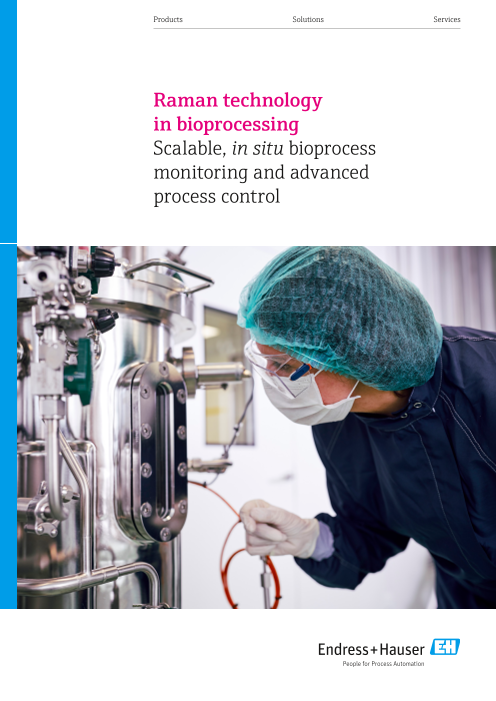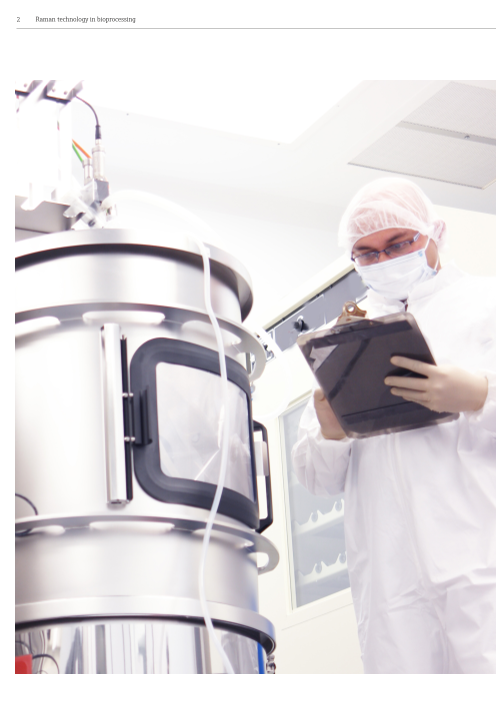1/12ページ
ダウンロード(6.8Mb)
スケーラブルなin situバイオプロセス モニタリングと高度な プロセス制御
Endress+Hauserのラマンアナライザーシステムは、細胞培養、発酵、または複数のパラメータをin situでリアルタイムにセンシングすることができます。私たちが提供するin situバイオプロセス解析は、Quality by Design (QbD)と高度なバイオプロセス制御を可能にします。
私たちの技術はお客様に合わせて拡張できるので、ラボからcGMPまで、従来のバイオリアクターやシングルユースバイオリアクター、バッチモードや連続モードでラマンを使用することができます。
このカタログについて
| ドキュメント名 | バイオプロセスにおけるラマンテクノロジー(英語) |
|---|---|
| ドキュメント種別 | 製品カタログ |
| ファイルサイズ | 6.8Mb |
| 登録カテゴリ | |
| 取り扱い企業 | エンドレスハウザー ジャパン株式会社 (この企業の取り扱いカタログ一覧) |
この企業の関連カタログ

このカタログの内容
Page1
Products Solutions Services
Raman technology
in bioprocessing
Scalable, in situ bioprocess
monitoring and advanced
process control
Page2
2 Raman technology in bioprocessing
Page3
A partnership for success 3
A partnership for success
Committed to helping you achieve operational excellence
Deliver consistent product
quality from the beginning The
Endress+Hauser Raman bioprocess
product portfolio, powered by Kaiser
Raman technology, provides in situ,
real-time analysis of nutrients,
metabolites, product quality, and
cell viability with a single probe. Our
equipment helps you deliver higher
yield and improved product quality
with reduced contamination risk and
greater efficiency.
Getting it right the first time We
understand continuous improvement
is key in a dynamic business and
regulatory environment. The trusted
scalability and performance of
Endress+Hauser analyzer systems
simplify your process equipment
complexity and ease method
transferability. Our training, advanced
analytics, support, and data modeling
services allow you to focus on your core
business while benefiting from our
experience to ensure a rapid return on
investment.
Complexity, simplified We put
our experience in instrument
manufacturing, process analytics,
data analysis, and life sciences into
the design and manufacturing of our
bioprocessing product line. You can
easily integrate Raman technology
for bioprocess advancement with full
confidence in our robust and reliable
analytical solutions.
Successes from process innovation to
process automation Endress+Hauser
has an established installation base
of more than 1500 units throughout
the world in GMP manufacturing
environments. Our continued growth
speaks to how much biopharmaceutical
industry leaders trust their products to
Endress+Hauser.
Page4
4 Ensure process and product quality
Ensure process and product quality
Benefit from our leading bioprocess analytical solutions and comprehensive
compliance offerings to get your lab-to-process analysis right the first time
Endress+Hauser Raman analyzer systems
provide in situ, real-time sensing of multiple
parameters for cell culture, fermentation, or
downstream bioprocesses. Our offerings for
in situ bioprocess analytics enable quality by
design (QbD) and advanced bioprocess control.
Our technology scales with you so that you
can use Raman for traditional or single-use
bioreactors, in batch or continuous mode, from
lab to cGMP.
We capitalize on our experience in life sciences
and closely work with industry leaders to provide
a wide selection of bioprocessing analytical
solutions. Ask our team of Raman experts about:
• Method development services
• Advanced training
• Service plans to help you reduce downtime,
avoid instrument requalification and protect
your process investment
Endress+Hauser’s compliance services help
you to improve your process and ensure
quality while maintaining cGMP. We carry
a ISO9001:2015 certification, ensuring
quality to our customers. Endress+Hauser
has over 10 years of experience building
ATEX, North American, and IECEx certified
Raman spectroscopic analyzers for output
into hazardous area installations. We also
provide NEMA 4X enclosures for wash-down
plant environments. Endress+Hauser is a Drug
Master File holder with the U.S. Food and Drug
Administration pertaining to reusable and
single-use bioprocess Raman probes.
We provide a comprehensive portfolio of
compliance services for cGMP applications
including:
Compliance with globally accepted standards & certifications • Questionnaire and audit support
• Standard and customized IQ/OQ
• Factory acceptance testing
• In-house audits
• Supplier qualification
• cGMP trained service personnel
Page5
Trusted Raman life science expertise 5
Trusted Raman life science expertise
30+ years in process Raman We understand the value Our comprehensive approach Endress+Hauser offers an
of being a trusted partner. Endress+Hauser Raman integrated Raman solution that is robust and reliable. It is
analyzer systems, powered by Kaiser Raman technology, comprised of high-performance analyzer equipment, user-
have an established history in the life sciences from our friendly embedded software, and in situ sampling probes. Our
first feasibility studies in the 1990s to our first GMP Raman analyzers have the same internal hardware to provide
installation in 2000. We worked with industry early consistent spectral response and high performance in location
to help solve their challenges and we continue to do specific packaging. Ask about our benchtop, cart-mounted,
so though our analysis products, compliance offerings, rack-mounted, or process area enclosures.
services, and support.
Our optimized bioprocess probes Endress+Hauser’s Raman
Our experience in life sciences From research to sampling probes are designed to meet the specific application
manufacturing, we have been a leading bioprocess and installation needs of bioprocessing. We provide optimized
monitoring and control solution provider for over 10 probes from lab to manufacturing scale, single use or reusable,
years. Our customers have shown that Raman can with our patented universal optical interface that deliver high
provide: quality spectra.
• Improved product quality
• Increased titer Our industry recognition In 2018, we received the industry-
• Higher volumetric productivity appointed Aspen Award for our contributions to Advancement
• Closed-loop feedback control of Upstream Bioprocessing. In 2020, our Rxn-46 bioprocessing
• Cross-scale and cross-platform method transferability probe was selected as a 2020 Pharma Innovation Award
• Automated feed control winner by Pharma Manufacturing Magazine.
• High density culture monitoring
Endress+Hauser is well known for our high-quality
analyzer and bioprocess probe instrumentation, process
automation knowledge, and cGMP expertise. Our strong
support of the life sciences means that you can rely on
us for your upstream and downstream bioprocess needs.
Proven Raman applications in bioprocessing*
“I need full application and development
support”
Cell culture Fermentation Downstream
Glucose Glycerol Aggregation Our response:
• We are your solution from technology
Lactate Methanol Protein crystallization to implementation
Glutamate Ethanol Formula stability • Our modeling, training, and advanced
analytics services provide an
Amino acids Sorbitol Product CQA opportunity for you to benefit from
Cell density Biomass Protein concentration our experience in life sciences and
expert application support so that you
Titer Buffer excipients can focus on your core business
* Additional product and process-related parameters are possible
Page6
6 Raman in laboratory and process development
Raman in laboratory and process development
Endress+Hauser has the widest selection of Raman offerings with proven lab
to cGMP scalability that is trusted by industry leaders
The Raman Rxn2 analyzer serves as an ideal bridge
from lab to process.When combined with our phase-
optimized sampling probes, the Raman Rxn2 offers
high-resolution performance for in situ, real-time
measurement and control.
Raman Rxn2 analyzers feature fully embedded
Raman RunTime software which ensures reliability
and seamless connectivity while supporting the
needs of Industry 4.0. Raman RunTime integrates the
spectrometer functions into the analyzer electronics
without needing a separate PC running proprietary
software. Raman RunTime exports raw data and
diagnostics using standard communication protocols
to support data integrity assurance.
Available as a benchtop or cart-mounted analyzer,
the Raman Rxn2 offers location flexibility for process
development laboratories. With up to four probes
per analyzer, measurement from four different
bioreactors or sampling points is possible with
a single system. The Raman Rxn2 has a unique
analyzer self-monitoring system and is available in
532 nm, 785 nm, or 1000 nm wavelengths.
In-process Raman in laboratory and process development applications
Page7
Raman in laboratory and process development 7
Rxn-10 probe with bIO-Optic Rxn-10 probe with Raman Raman RunTime
optic system for single use
• Compatible with bioprocess Lab-to-cGMP software for
industry standard ports • Disposable fitting for single- bioprocess monitoring and control
• PG13.5 threaded connector use bioreactors (SUB), plus a
• 120, 220, 320 or 420 mm non-contact reusable optic Benefits of lab and process
length • Developed to industry development
• Autoclavable standards for single-use • Intuitive touch screen interface
sensors • Auto-calibration
• Gamma sterilizable • Compatible with multiple
• Tested and supplied by multivariate data analysis
multiple SUB vendors (MVDA) predictors
• OPC and Modbus enabled
for integration with 3rd party
control systems
For information about robust model building via the integration of our Rxn-46 probe and Sartorius’s Ambr® 15
and Ambr® 250 product lines, please see our “Raman bioprocessing solution compatibility with BioPAT® Spectro by
Sartorius” brochure.
Page8
8 Raman in process and cGMP
Raman in process and cGMP
Ensure your manufacturing project’s success with our comprehensive package
of process analytical solutions
The Raman Rxn4 analyzer is a robust process
Raman analyzer, delivering 24/7/365 performance
and high precision that is essential for seamless
calibration transfer.
Like the Raman Rxn2, the Raman Rxn4 analyzer
features fully embedded Raman RunTime software
which ensures reliability and seamless connectivity
while supporting the needs of Industry 4.0. Raman
RunTime integrates the spectrometer functions into
the analyzer electronics without needing a separate
PC running proprietary software. Raman RunTime
exports raw data and diagnostics using standard
communication protocols to support data integrity
assurance.
The Raman Rxn4 is available as a 532 nm, 785 nm,
or 1000 nm rack-mounted analyzer for control
room installations, or in a NEMA 4X enclosure for
production floor installations. It has a unique analyzer
self-monitoring system to ensure the validity of each
measurement. The Raman Rxn4 analyzer is capable of
self-calibration and utilizes self-diagnostics and self-
correction methods.
In-process Raman in pilot and cGMP applications
Page9
Raman in process and cGMP 9
Rxn-10 probe with Raman Rxn-45 probe Raman RunTime
optic system for single use
• Compatible with bioprocess Lab-to-cGMP software for
• Disposable fitting for single- industry standard housings bioprocess monitoring and control
use bioreactors (SUB), plus a for 25mm side ports
non-contact reusable optic • PG13.5 threaded connector Benefits for process and cGMP
• Developed to industry with 120 mm probe length • cGMP compliant ready
standards for single-use • Wetted material surface • Intuitive touch screen interface
sensors finish Ra 15 with • Auto-calibration
• Gamma sterilizable electropolish • Compatible with multiple MVDA
• Tested and supplied by • CIP/SIP compatible predictors
multiple SUB vendors • OPC and Modbus enabled for
• cGMP qualified integration with 3rd party control
systems
• Integrated to leading PAT
management systems
Please see the “Raman bioprocessing solution compatibility with BioPAT® Spectro by Sartorius” brochure for information
about the integration of our Rxn-46 probe and Sartorius’s Biostat STR® single use manufacturing product line.
Page10
10 Application successes in upstream
Application successes in upstream
Increased titer up to 85% and improved product quality with Raman-based
glucose or lactate control in a mammalian cell bioprocess
Customer successes
with Raman applications
Cell culture and fermentation
• Real-time CPP and CQA
monitoring and control
• Increased productivity
• Improved product quality
• Cross-scale and cross-
platform model transfer
• Automated feed control
• Advanced process control
• Raw material qualification
• Cell and gene therapies
Contact Endress+Hauser
for technical references
Schematic of Raman-based feedback control
Production of protein therapeutics by mammalian cells is the most widely used bioprocess because of its ability to
properly produce and fold a recombinant protein. 60-70% of biopharmaceuticals are produced in this way. Bioreactor
parameters affect cell metabolic processes and detailed bioreactor knowledge is needed to achieve a balanced and
consistent metabolic state of cultured cells.
Glucose is a critical process parameter because it affects the cell’s metabolic profile, production of waste products and
post-translational non-enzymatic glycation of proteins. Continuous glucose measurements, using Endress+Hauser Raman
equipment, offer insights for important bioprocess understanding and enable feedback control from process development
to manufacturing.
In studies performed by Berry et al1 and Matthews et al2, Raman-driven feedback control systems were rapidly
implemented and demonstrated the ability to improve a biopharmaceutical protein’s product quality as well as a yield
increase of 85% over the historical process. Significant automated control was achieved after only two calibration steps
and quickly integrated into process development work. Raman was able to support a targeted concentration condition or
a stepwise condition, demonstrating Raman as a robust method to integrate into a controller of an industrially relevant
bioprocess. Endress+Hauser’s Raman technology is easily integrated into bioreactor controllers, and is a proven Process
Analytical Technology (PAT) solution able to provide real-time process control and ensure biopharmaceutical product
quality.
References:
1. Berry BN, et.al. (2016) Biotechnol Progress 32:224–234 . doi: 10.1002/btpr.2205
2. Matthews TE, et.al. (2016) Biotechnol Bioeng 113:2416–2424 . doi: 10.1002/bit.26018
Page11
Application successes in downstream 11
Application successes in downstream
Rapid optimization of protein crystallization conditions
Customer successes
with Raman applications
Cell culture and fermentation
• Flow cell sampling
• Protein and excipient
quantification
• CQA and aggregation monitoring
• Continuous chromatography
• Product concentration and buffer
exchange – UF/DF, TFF
Contact Endress+Hauser
for technical references
The protein structure of lysozyme (left) is affected by temperature, pH, precipitating agent, and
crystallization time.1 Raman spectra of lysozyme is depicted in the presence of acetate buffer at
90 mg/ml (right, top), 30 mg/ml (right, middle) and 0 mg/ml (right, bottom).
Raman spectroscopy is an established PAT for understanding crystallization in small molecule active pharmaceutical
ingredients and protein therapeutics. Similar to small molecules, protein crystallization may be affected by temperature,
pH, solvent, and concentration of species in the system. Raman spectroscopy was used to monitor a laboratory scale batch
crystallization of lysozyme. In situ Raman spectroscopy was used to investigate the effect of temperature, concentration of
precipitating agent, time of crystallization, and possible interactions between these factors.
The Raman spectra of a protein contains spectral contributions from the protein backbone and side chains. The amide III
envelope at ~1240 cm-1 and the amide I envelope at ~ 1650 cm-1 provide higher order structure information such as the
presence of a-helix, ß-sheet or random coil. In the example by Mercado et al, bands at 750, 760 and 2950 cm-1 yielded
useful protein structure information, reporting on the chemical environment of tryptophan (750, 760 cm-1) and CH3 groups
in aliphatic residues (2940 cm-1).2 Intensities of these bands, and the 760:750-cm-1 band area ratio, were sensitive to the
effects of NaCl concentration, temperature, and time on lysozyme crystallization.
Raman-derived surface plots indicated that optimal conditions for lysozyme crystallization were within 35–40 °C and
5–9% (w/w) NaCl. These data could form the basis of a crystallization design space for scale-up, and process development
studies. In situ Raman spectroscopy was effective in monitoring the effects of temperature, time, and NaCl concentration
on the crystallization of a model protein. Raman spectra provided information on the protein backbone and side chains,
which was used to generate quantitative process knowledge and determine optimal crystallization conditions. Extension
of the technique to biopharmaceutical laboratory or process development environments can be achieved using the Raman
Rxn2 analyzer platform, and in cGMP manufacturing environments using the Raman Rxn4 analyzer platform.
References:
1. Protein structure: 10.2210/pdb253L/pdb
2. Mercado, J. et al. “Design and In-Line Raman Spectroscopic Monitoring of a Protein Batch Crystallization Process.” Journal of Pharmaceutical
Innovation, December 2008, 271–279.
Page12
www.addresses.endress.com
IN01228C/66/EN/01.21








